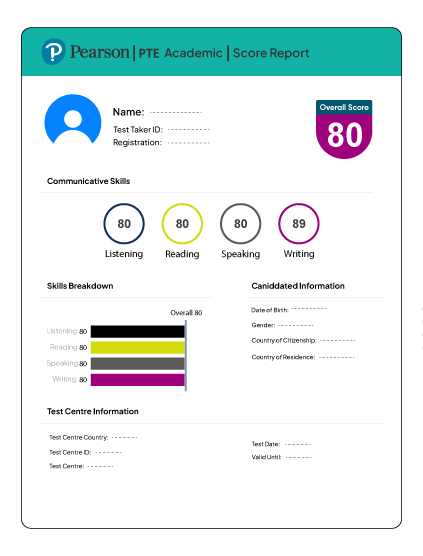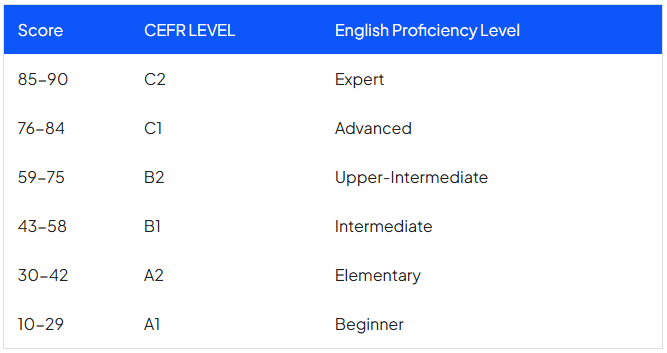Waiting for the results after taking the test can be stressful. Once you receive your PTE score report, it’s time to crack the code and see what those numbers mean for your future. This guide will be your key to understanding the PTE score chart, helping you decipher your results and plan your next steps confidently.
PTE Score Chart Explanation:
The PTE score chart utilizes a Global Scale of English (GSE) ranging from 10 to 90. This single Score decides the minimum PTE Score requirement for your desired universities analyzed based on the overall result of all 4 sections: reading, listening, speaking, and writing.
However, the score chart offers more than just a single number. It also provides individual scores for each communicative skill, giving you a detailed picture of your strengths and weaknesses. This breakdown allows you to identify areas for improvement and tailor your future studies accordingly.
Components of your PTE Score Chart / PTE Score Card Report:
Overall Score (10-90): The headline represents your English proficiency.
Communicative Skills Scores (10-90): These scores represent your performance in each of the four testing skills:
- Reading
- Listening
- Speaking
- Writing
The PTE score report doesn’t simply average the communicative skill scores to arrive at the overall Score. It uses a sophisticated algorithm that considers the weightage of each skill and your performance within each skill area.

Score Range
The PTE score you achieve reflects your overall English proficiency across listening, reading, speaking, and writing. Here’s a breakdown of what each score range indicates:
Masterful (85-90), (CEFR Equivalent: C2)
- Effortless Communication: You can effortlessly understand everything spoken in English, regardless of complexity or speed.
- Advanced Reasoning: You can summarize information, readily construct arguments, and analyze complex topics.
- Flawless Expression: You can express yourself fluently and precisely, even in challenging situations, demonstrating a rich vocabulary and mastery of grammar.
Very Good (76-84), (CEFR Equivalent: C1)
- Strong Comprehension: You can easily understand long, complex texts, grasping the main ideas and underlying concepts.
- Fluent Expression: You can express yourself fluently without struggling to find the right words, conveying your thoughts clearly and effectively.
- Detailed Writing: You can create well-structured and detailed texts, even under challenging circumstances, demonstrating strong writing skills.
Good (59-75), (CEFR Equivalent: B2)
- Confident Communication: You can confidently discuss and understand abstract topics and engage in conversations with native English speakers with ease.
- Clear Writing: You can create clear and concise text on a variety of everyday topics, effectively communicating your ideas.
Competent (43-58), (CEFR Equivalent: B1)
- Practical English: You can handle everyday communication effectively in situations related to school, work, and leisure activities.
- Basic Writing: You can create simple texts on familiar topics, conveying essential information.
- Expressing Yourself: You can explain your experiences, plans, and goals.
Developing (30-42), (CEFR Equivalent: A2)
- Limited Communication: You can understand essential information and basic expressions related to personal topics.
- Simple Interactions: You can communicate using simple phrases and expressions to manage fundamental interactions.
- Essential Concepts: You can describe common concepts in straightforward terms.
Beginner (10-29), (CEFR Equivalent: A1)
- Basic Greetings: You can use basic phrases and expressions to introduce yourself and ask for simple information from others.
- Slow Speech: You can understand a native English speaker if they speak slowly and pronounce clearly.

CEFR- Common European Framework of Reference for Languages
Making the Most of Your PTE Score and Skills Profile
Your PTE score and Skills Profile are valuable tools for both university applications and immigration purposes. Here’s how to leverage them effectively:
University Applications:
- Top Universities: Aim for a score in the “Good” to “Very Good” range (79-90). This demonstrates strong English proficiency, which is essential for academic success with English lectures, assignments, and discussions.
- Other Universities: Research specific requirements. Some universities may accept scores in the “Competent” band (70-78). Be aware that different programs within a university might have higher score requirements.
Immigration Purposes:
- Meet the Benchmark: Research the minimum PTE score required for your target immigration program and ensure your Score meets or exceeds that benchmark.
Targeted Improvement:
- Skills Profile as a Guide: Use the Skills Profile to pinpoint improvement areas.
- Focus Your Studies: Use targeted study materials and practice exercises to strengthen your weaker areas, such as reading comprehension, writing, speaking, and listening.
Track Your Progress (for Retakes):
- Baseline & Monitoring: If you plan to retake the PTE, use your previous score report and Skills Profile as a baseline. Track your progress over time and tailor your studies accordingly to maximize your Score on the next attempt.
Ready to see your PTE results? Here’s how to access them:
- Head to your myPTE account: This is the same PTE account you used to register for the test.
- Log in and look for “My Activity.” Once you’re in, find the section labeled “My Activity” or something similar.
- Find your test and view the Score: Locate your specific test date and click the button next to it that says “View Score” or something similar.
- Download or print (optional): If you want a copy, you can download the report as a PDF to keep for your records.
To reach your targeted Score, you need to practice first. Gurully provides you with an online platform for practicing the PTE Exam. Our language proficiency practice platform gives you full-length mock tests, which are AI-powered, so you get the results instantly. We also have the latest prediction files you can use to know the upcoming exam format. You can also practice on section-wise tests to score high on the exam.
Conclusion:
Don’t just see your PTE score as a single number. The PTE score chart is a roadmap to your English language strengths and weaknesses. By analyzing your Score alongside the Skills Profile, you gain a deeper understanding of the areas you excel in and those that might need extra attention.
This valuable information empowers you to set achievable goals, tailor your learning approach, and confidently reach your academic or professional English proficiency goals.
Also Read:







